Tech for Good in Family: Challenges and Suggestions of Family Online Protection

Sub Title: Stephen Balkam's presentation at Tencent Tech For Good | Beijing, China
Source:

It is good to be back here in China and, in particular, Beijing, which I first visited in 2002.
I’d like to begin with a brief description of my organization, the Family Online Safety Institute or FOSI for short. Then provide a definition of online safety, how we think of digital citizenship and how to respond to the many challenges and opportunities that digital technology poses to children and their families. And I’d like to leave you with an inspirational program to combat cyberbullying and to look ahead to what we can expect in the coming years.
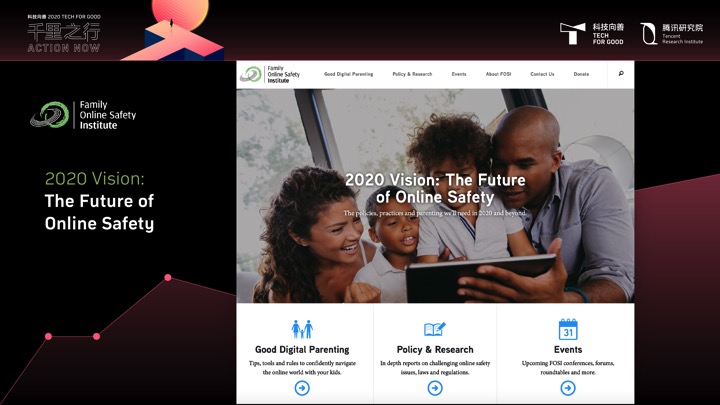
So, FOSI is an international, non-profit organization based in Washington, DC that works to make the online world safer for kids and their families.
We convene leaders in industry, government and the non-profit sectors to collaborate and innovate new solutions and policies in the field of online safety.
And through research, resources, events and special projects, FOSI promotes a culture of responsibility online and encourages a sense of digital citizenship for all.
We aim to be inclusive, transparent and non-partisan in all that we do. We believe in a bottom-up, multi-stakeholder approach that is evidence-based and empowering. While acknowledging the many and varied risks and threats online, FOSI also promotes the positive and enriching use of digital technology in all its forms.
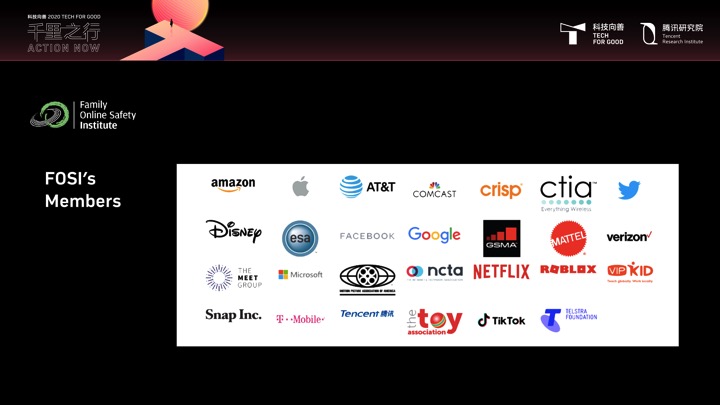
We are a membership organization and we have nearly 30 of the leading tech companies in the world as members, including Tencent, as well as Facebook, Twitter, Google and Amazon among others.

We work in what we call the 3P’s of Policy, Practices and Parenting. Or, more specifically, enlightened public policy, industry best practices and good digital parenting. We combine what we have learned from the online safety laws and regulations together with the rules and tools that industry has put in place to create simple, easy to understand guidance to parents as they struggle to bring up their kids in this digital world.
And, before I go any further, I’d like to offer a definition of online safety. We believe it involves:

Acknowledging the risks, mitigating the harms while reaping the rewards of our and our children’s digital lives. You cannot get the rewards if you don’t take risks – one way to be risk-free is to take all the technology away from our children. But then they wouldn’t benefit from the immense rewards that the online world has to offer.

I’d also like to offer some thoughts on what we mean by digital citizenship. We think of it as a pyramid, with safety, security and privacy as the foundation. Without feeling safe, secure and private online, it is very hard to develop the next level of skills.
These are digital and media literacy. Digital literacy is the ability to understand and set up digital devices, connect them to the Internet and to each other and to download and use software, apps and storage services.
Media literacy speaks of our understanding and discernment of the sources of information that comes through our devices. Being able to differentiate between a real and fake news source, for instance.
And, at the top, are our rights and responsibilities as citizens online. While there are many cultural differences about what constitutes free expression, having the right to speak and publish online is a very important aspect for us at FOSI.
But with rights come responsibilities and so what we say and do online must be tempered by our duty not to harm or inflame or harass others. Not to spread false information or rumors and to report bad behavior – to the platforms and to the police, if necessary, rather than ignoring it.
So, with all of this in mind, I’d like to describe the multi-faceted approach we take when considering how best to respond to the many online safety issues and challenges facing us and our children.

We believe we need to create a Culture of Responsibility online. One that involves different, but overlapping areas of responsibility across society and involves the kids themselves.
Firstly, we need reasonable government oversight and support. These are the laws and regulations needed to keep kids safe online. But government can also provide funding for research as well as educational campaigns to raise awareness of the risks and how best to benefit from digital technology.
We need well-resourced law enforcement that has the tools and means to go after bad actors online, while ensuring that they don’t misuse their policing powers.
Industry must create robust and comprehensive tools to provide parents with the ability to control what their kids see and do online while also providing users with the ability to quickly and effectively report on abusive behavior and content.
Teachers and librarians need to know how to pass on effective and age-appropriate online safety messages to their students and young people. To be most effective, online safety should be a part of every lesson, not just tech-specific work such as coding and web development courses.
Parents need to be empowered to confidently navigate the web with their kids. They must have timely and relevant help to set parental controls and create household rules for their children.
Finally, we must involve young people in this effort. By understanding their online experience, we can better help them to build resiliency in order to deal with the kind of content and situations that will inevitably confront them as they get older and use technology more.
To help them make wise choices about the content they post and consume; about who they contact and who they allow to contact them. And how they conduct themselves online – being upstanders and not bystanders.
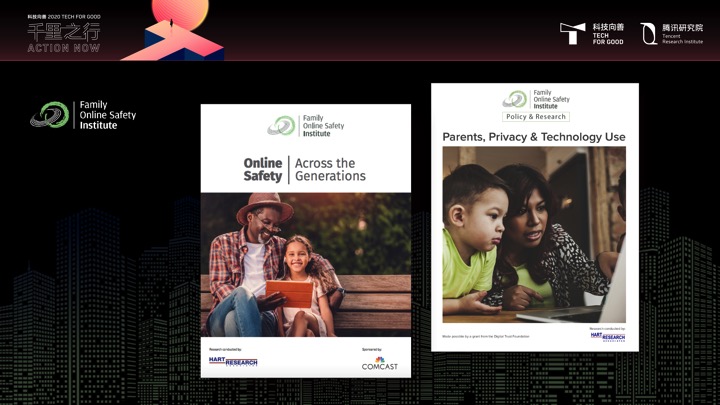
And now, I’d like to shift gears and look at what the research is telling us. We work with our members to conduct original research and here are two examples of recent reports: “Online Safety Across the Generations” and “Parents, Privacy and Technology Use”.
I’d like to pull out some interesting statistics that will help to illustrate the online safety landscape.
From our generational study, we found that parents are much more likely to think that technology has made communication among their family better (57%) than worse (13%).
Families with children who had a social media account first allowed them to do so at an average age of 11.4 years old. And for those whose children who had a smartphone, the average age of them getting one is 10.4 years.
In a recent Pew Research study, 95% of teens reported that they had a smartphone or access to one. And 45% of teens are online on a near-constant basis.
Amongst American teens, YouTube (85%), Instagram (72%) and Snapchat (69%) are among the most popular platforms.

Returning to our 2018 research and as you can see from this slide, parents reported that the top benefits for their children included the development of technology skills (+77), the ability to research and find information (+71) and for their child’s future, career and life skills (+50).
On the other hand, parents reported that among the negative effects of technology on their kids included the impact on their physical activity and fitness (-33), their attention spans (-12) and their ability to interact and engage with people in person (-5).
Parents are far more concerned about online content (64%) than time spent online (32%) when it comes to their children’s online and technology use.
And, finally, parents of connected children are nearly twice as likely to feel that technology and the Internet have made their job as a parent easier (53%) rather than harder (28%).
One of the ways that technology has made the job of parents easier is the increasing use of parental controls. In the US, these are now available in all the operating systems, browsers, search engines, social media and gaming platforms as well as through third party software tools and apps.
They can be used on computers, tablets, smart phones, gaming consoles and wifi routers.
Some are free, such as the filter in YouTube. Others charge a one-off fee or a monthly subscription. These tools cover the range of issues from inappropriate content, screen time and privacy to in app purchases and age limits.
Admittedly, it is a dizzying array of choices and options and some controls are easier to find and to use than others. It also depends on parents knowing that these tools even exist. Then there is the vexed question of how easy it is for kids, particularly teens, to get around the controls set by their parents or teachers. And while you may be able to block a child from using a phone, you may not be able to do the same on a wifi-enabled tablet.
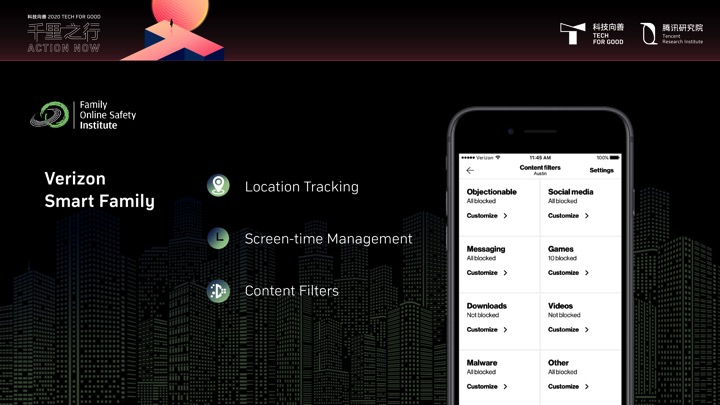
That being said, I’d like to use Verizon’s Smart Family, as an example of a network provider creating a comprehensive and intuitive solution for busy parents.
From the illustration you can see that Smart Family works as a location tracker, a content filter and a screen time manager. It even has a Pause the Internet button when you want your kids (and spouse) to drop everything and come to dinner!
What is also particularly smart about this product is that it works across the Verizon network as well as the wifi router in the home. And, as you can see, it has specific categories that you can switch on and off, in discussion with your kids.
A question I get asked more than any other about kids and technology is: What age should I buy my child a smartphone? As you heard earlier, our research shows that age has dropped, on average, to just 10 years old.
However, an increasing number of parents are waiting to buy their kids a phone – at least until they are 13. In the meantime, new products are now available in the US that allow you to both track and contact your child and they contact you, but not gain access to the Internet and the millions of apps that now reside on the App store.

Here is a picture of the Gizmo watch, also by Verizon. Yes, it tells the time. But it also allows a child to call or text up to 10 numbers, programmed by the parent. It is also a GPS tracker so a parent can check in to see where their son or daughter is without bothering them in class. It also has a few fun features and a step counter to give it a cool factor amongst the younger set.
We strongly advise parents who want to be able to reach their pre-teens or to see where they are, to go for these kinds of smart watches rather than handing a 7 or 8 or 9-year-old a phone that is also a web connected super-computer.
So, we’ve considered the many issues that confront parents and care givers in keeping their kids safe online. We’ve looked at the research – the main benefits as well as concerns – that parents have. And we’ve touched on the technology tools that are available. But is that enough? Are the parental controls strong enough and accurate enough to always protect your children?
Well, not on their own. Technological tools are vital, but they must be used alongside a personal, well-developed approach to online safety at home. That’s why we’ve developed a number of resources and, in particular, the 7 Steps to Good Digital Parenting.

Chief among them is to: Talk with your kids. Having an open, honest conversation from an early age and keeping that conversation going throughout their teen years is vital.
You convey your values as a parent, you let them know what is and is not acceptable for them to access and to do or say. And it allows your child to let you know when they come across disturbing or upsetting things online.
We encourage parents to educate themselves about not just the digital devices they and their kids use, but also the apps and games their children download and play.
It is a good idea to sit down and ask your child to show you what they are doing online and to get involved in their digital lives. Kids are delighted when their parents show an interest in the digital places they go and the games they play.
Our final step is, perhaps, the most challenging. We encourage parents to be good digital role models, themselves. One of the big complaints we hear from kids is that they can’t get their parents attention. Mom’s always on Facebook. Dad’s always just checking his email.
We need to put our devices down and give our kids our undivided attention, eye contact and warm touch. And when we do go online, show them how to act civilly and with respect when responding on social media.
In the US we say, kids will do what we do and not what we tell them to do. So, we need to model that good, healthy digital behavior as much as we can.
And when we set the rules for our family’s tech use, make sure to involve the kids and get their input. They will be much more likely to adhere to the time limits and content controls if they have had some say in what the restrictions and the consequences are.
While I’ve talked a good deal about controls and restrictions, I’d also like to emphasize a very important aspect in a young person’s growth and development. And that is resilience.
It is vital that we protect our younger children from the worst of the web: pornography, violent images, too much screen time. It is also imperative that as we give our teens and young people more online freedoms, that we help them to develop the means to deal with difficult or challenging situations.
This means teaching them to use the tools at their disposal to protect themselves and others online – involving parents when they’re younger, and acting on their own as they grow up.
Learning to report illegal content and flag offensive behavior means that kids are empowered to be responsible for the technology that they use every day. This empowers them to minimize the impacts of bad actors, and play an active part in helping themselves and others handle the potential risks of online life.
Empowering young people to recover quickly from upsetting experiences is one of the greatest gifts we can give the next generation.
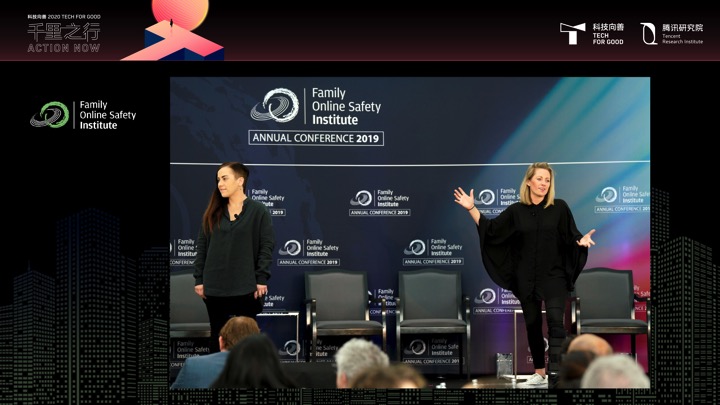
A wonderful organization based in Melbourne is attempting to do just that. Project Rockit was created by two sisters, Lucy and Rosie Thomas, seen here at the FOSI 2019 conference in Washington just two months ago.

They have recruited young people across Australia to be Digital Ambassadors where children are trained and empowered to deal with bullying both online and off.
The program unites students across Australian schools to participate in a national movement of change against (cyber)bullying, that is led by young people for young people.
The program provides youth-driven training of young people focused on building peer networks to create supportive online communities. Together with ongoing online resources, Digital Ambassadors are equipped with the tools to spark their own school-based social action and are empowered to build a safer, kinder digital world.
And here are just a few of them. I am hugely encouraged by initiatives such as these. Where children and young people are encouraged and given the tools to tackle issues that they uniquely experience in ways that most adults cannot comprehend.
It also moves away from the passive model of protection and shutting down, to a more active and positive stance against harassment and for kindness and compassion.
Finally, I want to leave you with a few thoughts about what the future holds for us and our kids.

We recently launched a White Paper entitled, “Online Safety in the Age of Artificial Intelligence” and considered all the ways that AI will impact children and their families. It is clear that AI will increasingly combine with the Internet of Things and advances in computing power to transform how we live, work, play and learn.
Children and their families will be at the forefront of these changes. We need to build in safeguards and controls while we design and develop the technology of the future and not wait to see what the negative effects will be and then try to fix it.
I am very impressed by what I’ve seen in the advances in AI here in China. If you haven’t done so already, I recommend the book, “AI Superpowers” by Kai Fu Lee which outlines the competitive and entrepreneurial spirit that has blossomed here, particularly in AI applications.
But I also remain concerned that as our technological advances increase exponentially, that we will not have the time or the bandwidth to create these new innovative products with children, families and safety in mind.
We will need to employ a Culture of Responsibility to ensure that all layers of society from government to law enforcement, the tech companies, parents, teachers and the kids themselves understand their different, but overlapping areas of responsibility for safety online.
Only then, will we be able to have Tech for Good.
 Family Online Safety Institute
Family Online Safety Institute